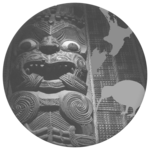| History of New Zealand |
|---|
 |
| Timeline |
| General topics |
| Prior to 1800 |
| 19th century |
| Stages of independence |
| World Wars |
| Post-war and contemporary history |
|
| See also |
|
|
| Part of a series on the |
| Culture of New Zealand |
|---|
 |
The human history of New Zealand can be dated back to between 1320 and 1350 CE, when the main settlement period started, after it was discovered and settled by Polynesians, who developed a distinct Māori culture. Like other Pacific cultures, Māori society was centred on kinship links and connection with the land but, unlike them, it was adapted to a cool, temperate environment rather than a warm, tropical one. The first European explorer known to have visited New Zealand was the Dutch navigator Abel Tasman, on 13 December 1642.[1] In 1643 he charted the west coast of the North Island, his expedition then sailed back to Batavia without setting foot on New Zealand soil. British explorer James Cook, who reached New Zealand in October 1769 on the first of his three voyages, was the first European to circumnavigate and map New Zealand.[2] From the late 18th century, the country was regularly visited by explorers and other sailors, missionaries, traders and adventurers. The period from Polynesian settlement to Cook's arrival is New Zealand's prehistoric period, a time before written records began. Use or otherwise of indigenous oral history as recorded history is a matter of academic debate. Depending on definitions, the period from 1642 to 1769 can be called New Zealand's protohistory rather than prehistory: Tasman's recording of Māori was isolated and scant.[3]
On 6 February 1840, the Treaty of Waitangi was signed between representatives of the United Kingdom and various Māori chiefs, initially at Waitangi and over the following weeks at other locations across the country. On 21 May 1840, New Zealand entered the British Empire when Lieutenant-Governor William Hobson proclaimed British sovereignty at Kororāreka (Russell). Disputes over the differing versions of the Treaty and settler desire to acquire land from Māori led to the New Zealand Wars from 1843. There was extensive British settlement throughout the rest of the 19th century and into the early part of the next century. The effects of European infectious diseases,[4] the New Zealand Wars, and the imposition of a European economic and legal system led to most of New Zealand's land passing from Māori to European (Pākehā) ownership, and Māori became impoverished.
The colony gained responsible government in the 1850s. From the 1890s the New Zealand Parliament enacted a number of progressive initiatives, including women's suffrage and old age pensions. After becoming a self-governing Dominion with the British Empire in 1907, the country remained an enthusiastic member of the empire, and over 100,000 New Zealanders fought in World War I as part of the New Zealand Expeditionary Force. After the war, New Zealand signed the Treaty of Versailles (1919), joined the League of Nations, and pursued an independent foreign policy, while its defence was still controlled by Britain. When World War II broke out in 1939, New Zealand contributed to the defence of Britain and the Pacific War; the country contributed some 120,000 troops. From the 1930s the economy was highly regulated and an extensive welfare state was developed. From the 1950s Māori began moving to the cities in large numbers, and Māori culture underwent a renaissance. This led to the development of a Māori protest movement, which in turn led to greater recognition of the Treaty of Waitangi in the late 20th century.
The country's economy suffered in the aftermath of the 1973 global energy crisis, the loss of New Zealand's biggest export market upon Britain's entry to the European Economic Community, and rampant inflation. In 1984, the Fourth Labour Government was elected amid a constitutional and economic crisis. The interventionist policies of the Third National Government were replaced by Rogernomics, a commitment to a free market economy. Foreign policy after 1984 became more independent, especially in pushing for a nuclear-free zone. Subsequent governments have generally maintained these policies, although tempering the free market ethos somewhat.
- ^ Wilson, John. "European discovery of New Zealand – Abel Tasman". Te Ara: The Encyclopedia of New Zealand. New Zealand. Retrieved 16 January 2010.
'On 13 December 1642 the Dutch sighted "a large land, uplifted high" – probably the Southern Alps ...'
- ^ "Trove - Archived webpage". Trove. Archived from the original on 5 February 2011. Retrieved 11 May 2023.
- ^ Stephen M. Perkins and Timothy G. Baugh (2008). "Land of Our Ancestors: Studies in Protohistoric and Historic Wichita Cultures". Plains anthropologist. 53 (208). Taylor & Fransis: 382.[better source needed]
- ^ Coleman, Andrew; Dixon, Sylvia; Maré, David C (September 2005). "Māori economic development – Glimpses from statistical sources" (PDF). Motu. pp. 8–14. Archived (PDF) from the original on 9 October 2022. Retrieved 4 May 2014.